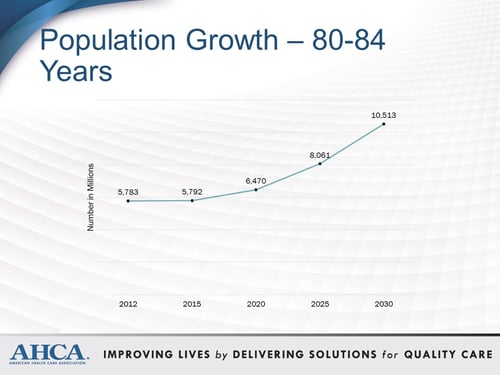December 14, 2017 | Peter Corless
December 14, 2017 | Peter Corless
 As we enter the final months of 2017, long-term care and senior living organizations are finalizing programs and new initiatives for 2018. I’ve even heard that many are starting to plan for 2019 and 2020, too. I applaud this forward thinking but would like to challenge those organizations to look even further down the road, given the looming staffing crisis.
As we enter the final months of 2017, long-term care and senior living organizations are finalizing programs and new initiatives for 2018. I’ve even heard that many are starting to plan for 2019 and 2020, too. I applaud this forward thinking but would like to challenge those organizations to look even further down the road, given the looming staffing crisis.
I’m talking about 2030—the year when the shortage will hit us the hardest. It might seem crazy to think ahead by 13 years, but it’s important to be strategic to remain viable during tough times.
While no one knows exactly what the future holds, here are a few changes senior care companies should be thinking about today, when preparing for what’s coming down the road.
Approximately 10,000 individuals turn 65 each day. According to a 2014 report from the U.S. Census Bureau, 20 percent of the population, or just over 70 million Americans, will be 65 years and older by 2030. And the population that needs our services most – those between the ages of 80 to 84—will grow from approximately 6 million today to an estimated 10.5 million in 2030 – a whopping increase of 75%.

As the aging population surges, hundreds of thousands of baby boomers will enter senior care communities, looking for assisted living, independent living, memory care or skilled nursing services.
With this increase in residents, organizations will experience some major pain points, particularly from a hiring standpoint. With an increase in residents, comes a greater demand for caregivers, and other support staff such as maintenance, dietary, laundry and administration that are vital for running a community and providing quality care for its residents. Organizations, specifically HR departments, will need to be prepared to recruit, interview and hire more workers as demand for senior care rises into 2030.
By 2030, the senior care profession will need 2.3 million more workers to care for the aging population. Given this number and the other workforce challenges that exist in long-term care and senior living, we will have to do more with less resources.
Workplace efficiencies will become extremely important as the staffing crisis continues. That’s where technology comes in. Providers will need to evaluate where the biggest oppurtunies for process improvements lie and implement programs that drive workforce efficiencies. Fortunately, modern solutions like staff scheduling software exist and make management’s job much easier—reducing time spent creating and managing the schedule, allowing more time to focus on care.
Today, organizations are focusing on how to attract and retain millennials, who now compose a majority of the workforce. But in 13 years, organizations will need to start planning for the generation of workers after millennials: Gen Z. Just as millennials are different from their baby boomer coworkers, Gen Z workers will carry their own unique set of characteristics that HR departments will have to identify. This means that they will also need to adjust workplace policies and programs accordingly to recruit, engage and retain this new group.
Both millennials and Gen Z rely on technology—specifically their phones—for just about everything, and providers can attract both groups by bringing tech to the workplace via mobile schedules.
Additionally, they’re innovative, goal oriented and tend to hold a more realistic attitude. For instance, they realize having a college degree doesn’t always guarantee a job or success. And having seen the effects of crippling student loan debt, a good portion may choose to skip college and head straight into the workforce and rely on employers to train and develop them. This generation wants professional development and, given the opportunity, could represent the future leadership of your organization.
Getting Ahead & Staying Ahead
Employee engagement isn’t going away anytime soon since the best way to lessen the burden of hiring is to retain the staff you have on hand. That said, over time, we’ll see an increase in innovate methods for keeping staff happy and engaged. Right now, providers can take advantage of automated employee rewards and recognition for good work, pulse surveys to receive immediate feedback on how employees are feeling about their job as well as employee financial wellness software to stand out from the competition.
It won’t be easy, but organizations that embrace the changing senior care workforce and adapt as necessary will likely come out on top. It’s evident that technology will be a huge driver of that success and implementing solutions that make employees' jobs easier and more enjoyable will become increasingly important as we trek toward 2030.
1 Courtesy of AHCA
Subscribe to the OnShift Blog
Recent Posts
Categories
About Peter Corless
Peter Corless is Executive Vice President of Enterprise Development for OnShift. Peter is a recognized HR leader in post-acute care and is well-known for his achievements at some of the country’s largest post-acute care organizations, including Kindred Healthcare and Genesis HealthCare. As an experienced, chief administrative and human resources officer within these organizations, he developed strategies that reduced turnover, improved recruiting and hiring strategies, and reduced labor costs.
See for yourself why thousands of providers rely on OnShift’s innovative software for recruitment, hiring, workforce management, pay and engagement. Request your personalized demo today.
